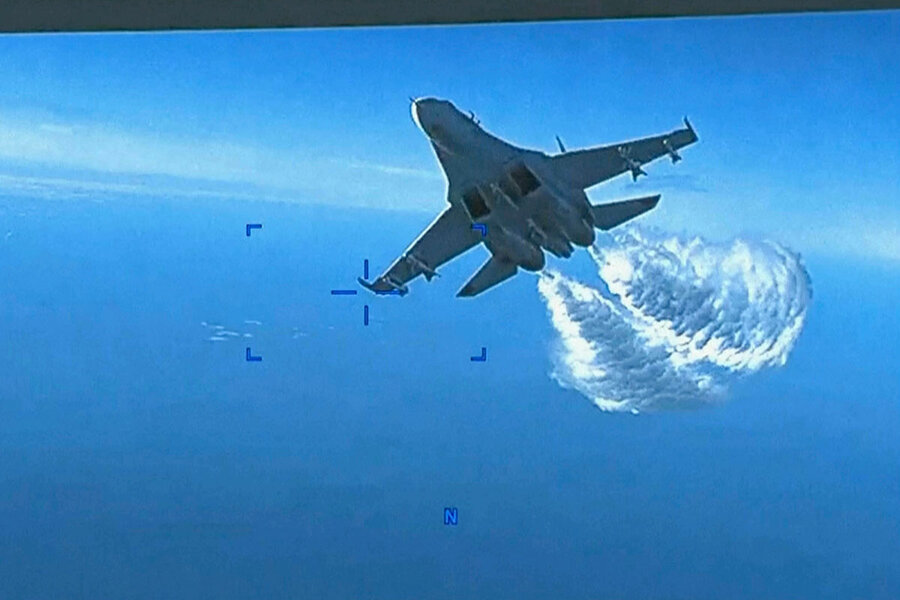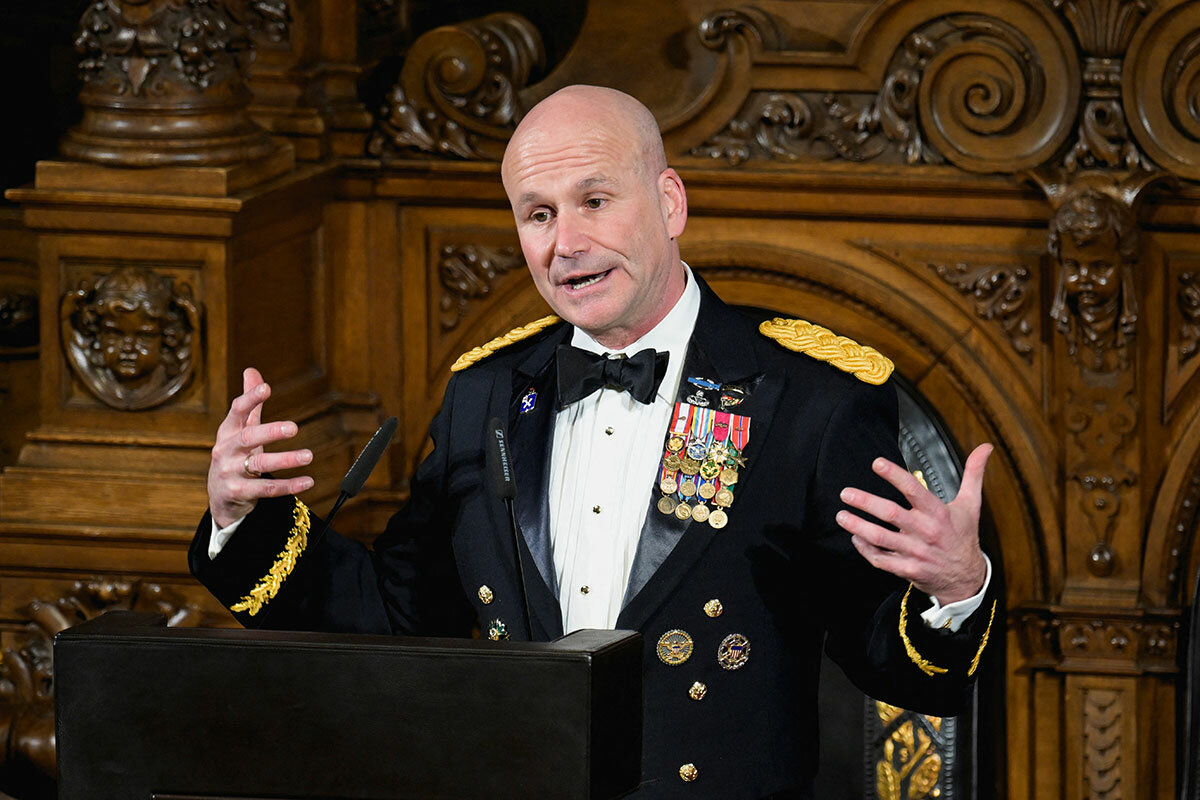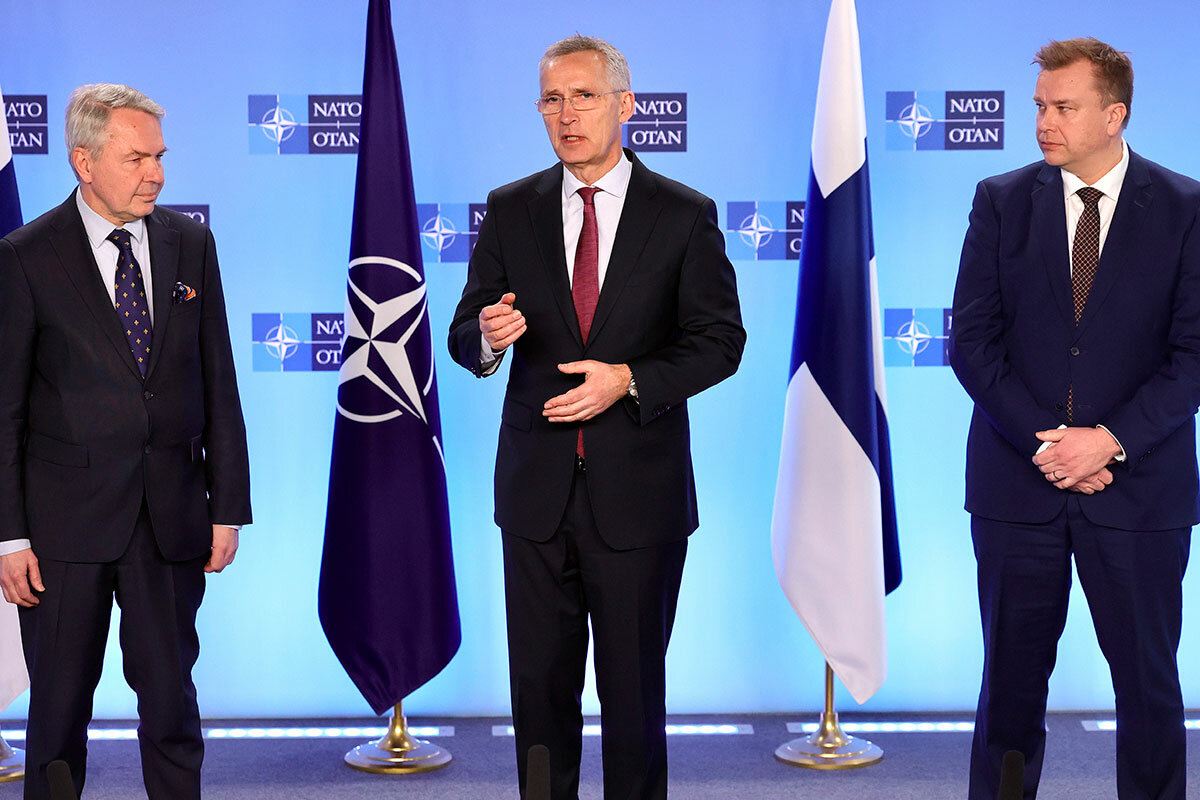As Ukraine war drags on, NATO steps up war readiness
Loading...
| MONS, Belgium
When two Russian fighter jets forced down an American surveillance drone above international waters a week ago, U.S. officials warned that the “reckless” move ratcheted up the risk of “miscalculations” and “misunderstandings” between the two nuclear powers.
Back at NATO’s strategic headquarters in a small village an hour southwest of Brussels, it was yet another incident driving home the urgency of the question keeping its planners busy around the clock: How, precisely, will NATO respond if Russia, either accidentally or intentionally, attacks a member the alliance has pledged to defend?
“Now this is a personal opinion,” Lt. Gen. Hubert Cottereau, vice chief of staff at NATO’s strategic headquarters, told the Monitor last week. “But I don’t know if we have already entered the third world war.” His point is not that NATO will soon be enmeshed in a far wider conflict, but rather to drive home how seriously military professionals take the risk of such a possibility. War preparation is a pathway, if not to peace, then to security.
Why We Wrote This
A story focused onThe NATO alliance has taken efforts to avoid being drawn directly into the conflict over Ukraine. Yet the longer war there goes on, the more urgent readiness becomes for alliance commanders.
One of the great hazards of war, after all – strategists throughout history have stressed – is their awful tendency to escalate suddenly. “Do you know what General MacArthur said? The biggest catastrophes can be summed up in two words: Too late,” notes Lieutenant General Cottereau, who recently served as the first-ever French deputy commander of a U.S. infantry division. “I don’t want to be too late. I want to be ready, if necessary, to fight tonight.”
For this reason, NATO has been quietly taking the step of putting its strategic headquarters on what military officials here are describing as “war fighting footing.” While it’s a shift being made without public proclamation or formal status, some of its elements were authorized by the alliance’s political council last year. Officials here characterize the move as a major one and key to what NATO Secretary-General Jens Stoltenberg calls the “biggest overhaul of [NATO’s] collective defense since the Cold War.”
It entails everything from reorganizing how NATO forces are commanded, to weaving artificial intelligence into planning in an effort to help predict the unpredictable, to introducing cultural shifts that make it easier to, say, ask staffers to work weekends.
Such steps become “more and more urgent” with each passing week of war in Ukraine, says Ian Lesser, vice president of the German Marshall Fund of the United States.
Poland’s pledge last week, for example, to send fighter jets to Ukraine – the first NATO nation to do so – while welcomed by Kyiv, carries with it a danger of escalation that makes some NATO allies nervous. (Slovakia followed Poland’s lead late Friday.) It was, in fact, a step roundly rejected by the United States and other nations a year ago for precisely this reason.
“As the conflict drags on, the accumulated risks of something going wrong – whether accidentally or deliberately that would involve the defense of NATO more directly – will grow,” Dr. Lesser says.
NATO’s current shifts are meant to mitigate these risks, says retired Gen. Frederick “Ben” Hodges, former commander of U.S. Army forces in Europe.
“The Russians are going to see what they might have hoped would be an alliance that was unsure of itself leaning forward even more,” he says. “And that is the best way to make sure the Russians don’t make a terrible miscalculation and attack any part of NATO.”
Given all of this, there’s widespread support within NATO among both uniformed personnel and civilian officials for the moves, says Lieutenant General Cottereau. “Everybody is convinced that something has to change – and has to change very, very rapidly.”
Centralizing resources
These changes started in Madrid last June with a NATO conference in which the North Atlantic Council, the alliance’s political body, agreed to put forces currently numbering some 41,000 – up from 4,650 in 2021 – under the command of U.S. Gen. Christopher Cavoli, NATO’s Supreme Allied Commander. The plan in the years ahead is to continue to grow these forces to 300,000.
This is necessary, alliance officials say, because after the fall of the Berlin Wall, NATO’s far-flung stability operations and diffuse anti-terrorism efforts meant that NATO’s top commander had for years “retained less control over the national armed forces of member countries,” says Rafael Loss, coordinator for pan-European data projects at the European Council on Foreign Relations in Berlin.
In the wake of the Russian invasion of Ukraine, however, officials at NATO’s Supreme Headquarters Allied Powers Europe (SHAPE) grappled with a realization: “We can’t order anybody to do anything. We build plans, we build strategy, we do all of those things, but the headquarters itself doesn’t issue orders,” a NATO military official says, adding that the thinking was, “That’s not going to work.”
The war in Ukraine is also consuming weapons and equipment at a pace “many times higher than our current rate of production,” Secretary-General Stoltenberg has warned. So SHAPE is now building future war plans to “centralize the allocation of scarce resources” since, should conflict erupt, there “will be tensions” on them, Lieutenant General Cottereau says. It is also encouraging the defense industrial complexes of member nations to produce more arms.
At the same time, NATO’s strategic headquarters, as part of its war fighting footing, has become “much more ambitious in exercising its forces and capabilities,” Mr. Loss says. This is important because in the post-Cold War years, though SHAPE developed training regimes, “it had very little say over what forces it could draw on to implement” them.
Now if NATO is practicing a maritime amphibious assault, for example, “then it can say that it would be a good idea to have a battalion of Dutch forces participate as well,” he notes.
Such exercises have aims beyond just reinforcing readiness: NATO planners work closely with strategic communications teams to “develop exercises around certain messages they want to send to Russia,” Mr. Loss adds. “And one of the messages they regularly intend to send is that NATO is able to do things that Russia is not.”
To aid commanders in the face of myriad complex demands, the headquarters will integrate artificial intelligence into its strategizing, Lieutenant General Cottereau says, with the ultimate aim of being able, “on the fly, to war-game the decisions we’re making during the fight.”
The goal is to use AI to “accelerate the decision-making process as well as to challenge what our military science tells us to do,” he adds. “With the AI we can cross-check our decisions.”
The war footing considerations also run to the low-tech, as SHAPE advises member states of the need to do things like invest in their old train tracks and roads.
Patriot missile systems and tanks have in some cases been sent to Ukraine via highways and byways because there isn’t enough railway capacity, a senior NATO military official notes. “If we let all these sophisticated weapons drive on the street” – exposing them to wear and tear – “that reduces their fighting power at the front line.”
“We’re thinking big”
Even in the service of quotidian demands, putting NATO’s strategic headquarters on war fighting footing has not been without controversy. There were those who initially bristled at the martial implications for an alliance that remains – officially, at least – at peace. Early in the invasion, enthusiasm for the idea tended to correspond with member nations’ proximity to Ukraine, NATO officials say. Yet as Russian brutality there continued unabated, members grew to overwhelmingly support the shift, they add.
But while the move may have made some member nations’ political leaders “uneasy” at first, says Mr. Hodges. “You can believe that the chiefs of defense” for these countries “understand exactly why this needs to be done.”
And they do, says Lieutenant General Cottereau, who led strategic planning for the Army’s 3rd Infantry Division at Fort Stewart, Georgia, from 2019 to 2021. During that time, he took only the American standard-issue vacation of two weeks in two years and soaked in some of the lessons America tends to impart.
“If you want to transform an organization, you have to think big,” he says. “And that’s what we’re doing – we’re thinking big.”
Even simply calling SHAPE a strategic “war fighting headquarters” within the alliance conveys a sense of urgency, he adds, and signals the need for empathy in the shared experience that comes with it.
“There is a huge distance not only physically but mentally between the strategic staff officer and the warfighter in the field who is freezing during the night, who is seeing his comrades dying, who is yelling for ammunition,” he says. “And that distance is the problem.
“The people who are working in their warm offices might not sense the urgency. That’s totally human as a tendency,” he adds. “But they have to be convinced of the necessity – the absolute necessity – of what they are doing.”









